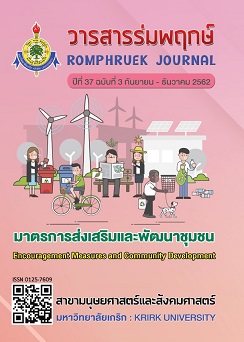Discriminant Analysis and Logistic Regression Analysis for Predicting the Decision Making to Choose the Government Organization to Work for of the Fourth Year Students in the Faculty of Management Science, Uttaradit Rajabhat University
Main Article Content
Abstract
The objectives of this research were to examine the discriminant analysis and logistic regression analysis for prediction in decision making of government organization choices after the 4th years graduation in the Faculty of Management Science, Uttaradit Rajabhat University. The sample in this research consisted of 212 students in the 4th years of the Faculty of Management Science, Uttaradit Rajabhat University using discriminant analysis and logistic regression analysis to analyze the proposed hypotheses and using descriptive statistics to analyze demographics data. The findings were found that factors affecting the decision of government organizations choices after graduation include personal factors and expectation variables from the family which were used as variables in the analysis is a significant variable in making the same decision in both methods. And the decision-making pattern using discriminant analysis methods can be accurately identified 73.1 percent and using Logistic regression analysis methods can be accurately identified 74.5 percent.
Article Details
Every article published in the Romphruek Journal of the Humanities and Social Sciences is the opinion and point of view of the authors. Thery're not the viewpoint of Krirk University or the editored department. Any part or all of the articles for pablication must be clearly cited.
References
กิ่งพร ทองใบ. (2553). แนวคิดพื้นฐานเกี่ยวกับการจัดการเชิงกลยุทธ์ ในเอกสารการสอนชุดวิชาองค์การและการจัดการ
และการจัดการเชิงกลยุทธ์ หน่วยที่ 9. นนทบุรี : โรงพิมพ์มหาวิทยาลัยสุโขทัยธรรมาธิราช.
ชณัฎฎา อมรวงศ์ไพบูลย์ และ เชี่ยวชาญ อาศุวัฒนกูล. (2561). การตัดสินใจเข้ารับราชการของนิสิตชั้นปีที่ 4
มหาวิทยาลัยเกษตรศาสตร์ วิทยาเขตบางเขน. วารสารสหวิทยาการวิจัย ฉบับบัณฑิตศึกษา, 7(1), 178-187.
พรทวี เถื่อนคำแสน และ บุญญรัตน์ สัมพันธ์วัฒนชัย. (2559). ปัจจัยที่มีผลต่อแรงจูงใจในการตัดสินใจเลือกทำงานของพนักงานระดับ ปฏิบัติการในนิคมอุตสาหกรรมเหมราช อีสเทิร์นซีบอร์ด จังหวัดระยอง. วารสารบริหารธุรกิจเทคโนโลยีมหานคร, 13(1),1-23.
พวงรัตน์ ทวีรัตน์. (2543). วิธีการวิจัยทางพฤติกรรมศาสตร์และสังคมศาสตร์. พิมพ์ครั้งที่ 8. กรุงเทพฯ : โอเดียนสโตว์.
ยุทธ ไกรวรรณ์. (2555). หลักการและการใช้การวิเคราะห์การถดถอยโลจิสติกส์สำหรับการวิจัย.
วารสารมหาวิทยาลัยเทคโนโลยีราชมงคลศรีวิชัย, 4(1),1-12.
สมประสงค์ เสนารัตน์. (2553). การจำแนกกลุ่มด้วยเทคนิค Discriminant Analysis. (4 ธันวาคม 2561).
สืบค้นจาก https://rci2010.files.wordpress.com/.
อรอุมา ทองหล่อ สุภาวดี มานะไตรนนท์ และ อนันท์ เชาว์เครือ. (2555). การวิเคราะห์จำแนกประเภทกับการวิเคราะห์
ถดถอยแบบโลจิสติกส์ทวิ สำหรับทำนายปริมาณน้ำนมของฟาร์มโคนม. KKU Science Journal, 40(4), 1195-1204.
Mberia A. & Midigo R. (2018). Understanding Career Choice Dilemma in Kenya : Issues of Informed
Choices and Course Availability. Journal of Education and Practice, 9(9), 35-40.
Cronbach, L. J. (1951). Coefficient alpha and the internal structure of tests. Psychometrika, 16, 297-334.
Halperin, M., Blackwelder, W. E. and Verter, J. I. (1971). Estimation of the multivariate logistic risk function : A comparison of the discriminant function and maximum likelihood approa -ches. J Chron Dis, 24, 125-158.
Hewitt, J. (2010). Factors influencing career choice. (4 December 2018) Retrieved from www.- ehow.com.
Lent, R. W., Brown, S. D., & Hackett, G. (1994). Toward a unifying social cognitive theory of career
and academic interest, choice, and performance [Monograph]. Journal of Vocational Behavior, 45, 79-122.
Montgomery, M. E., White, M. E. and Martin, S. W. (1987). A comparison of Discriminant Analysis and Logistic Regression for the Prediction of Coliform Mastitis in Dairy Cows. Can J Vet Res, 51, 495-498.
Nunnally, J. C. (1978). Psychometric theory. New York : McGraw-Hill.
O' Glenn, Stahl .(1962) . Public Personnel Administration. New York : Harper and Row.
Omari, S. G. (2013). Strategic Factors That Influence Students’ Career Choice In Kenya Universities : A Study of United States International University. Chandaria School Of Business United States International University, Africa.
Ulrich D. and Dulebohn James H. (2015). Are We There Yet? What’s Next For Hr?.
Human Resource Management Review, 25, 188–204.
Yamane, T. (1976). Statistics : An introductory analysis (2 nd ed.). New York : Harper and Row.


